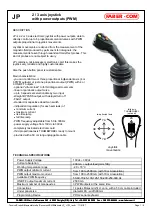
Instruction Manual
D100306X012
657 Actuator (30/30i-70/70i and 87)
June 2018
13
2. Position the lower diaphragm casing (key 5) on the yoke (key 9), and fasten the parts together by installing and
evenly tightening the cap screws (key 8).
3. Set the actuator spring (key 6) squarely onto the spring seat (key 11).
4. If the diaphragm plate and actuator stem (keys 4 and 10) are separate, fasten them together using the cap screw
and washer (keys 3 and 25). Coat the cap screw threads with lithium grease (key 241). Tighten the cap screw (key 3)
to 41 N
S
m (30 lbf
S
ft) torque for size 30/30i actuators, 54 N
S
m (40 lbf
S
ft) torque for size 34/34i and 40/40i actuators,
or 149 N
S
m (110 lbf
S
ft) torque for size 45/45i to 87 actuators. Slide the actuator stem and diaphragm plate (keys 10
and 4) into the yoke (key 9) so that the actuator spring (key 6) fits squarely between the diaphragm plate and the
spring seat (key 11). Then slide the diaphragm rod through the spring adjuster (key 12).
Note
Key 25 is not part of size 40 and 40i constructions.
5. Place the diaphragm (key 2) pattern‐side up on the diaphragm plate (key 4). Align the holes in the diaphragm and
the lower diaphragm casing (key 5).
6. Position the upper diaphragm casing (key 1) on the diaphragm (key 2) and align the holes.
Note
When you replace actuator diaphragms in the field, take care to ensure the diaphragm casing bolts are tightened to the proper
load to prevent leakage, but not crush the material. Perform the following tightening sequence with a manual torque wrench for
size 30/30i‐70/70i and 87 actuators.
CAUTION
Over‐tightening the diaphragm casing cap screws and nuts (keys 22 and 23) can damage the diaphragm. Do not exceed 27
N
S
m (20 lbf
S
ft) torque.
Note
Do not use lubricant on these bolts and nuts. Fasteners must be clean and dry.
7. Insert the cap screws (key 22), and tighten the hex nuts (key 23) in the following manner. The first four hex nuts
tightened should be diametrically opposed and 90 degrees apart. Tighten these four hex nuts to 13 N
S
m (10 lbf
S
ft).
8. Tighten the remaining hex nuts in a clockwise, criss‐cross pattern to 13 N
S
m (10 lbf
S
ft).
9. Repeat this procedure by tightening four hex nuts, diametrically opposed and 90 degrees apart, to a torque of 27
N
S
m (20 lbf
S
ft).
10. Tighten the remaining hex nuts in a clockwise, criss‐cross pattern to 27 N
S
m (20 lbf
S
ft).
11. After the last hex nut is tightened to 27 N
S
m (20 lbf
S
ft), all of the hex nuts should be tightened again to 27 N
S
m (20
lbf
S
ft) in a circular pattern around the bolt circle.
12. Once completed, no more tightening is recommended.
13. Mount the actuator on the valve by following the procedures in the Installation section.
Top‐Mounted Handwheel Assembly
A top‐mounted handwheel assembly (figures 11 and 12) is usually used as an adjustable casing‐mounted up travel
stop to limit full retraction of the actuator stem. Turning the handwheel clockwise moves the the handwheel stem
(key 133, figures 11 and 12) down, compressing the spring.














































